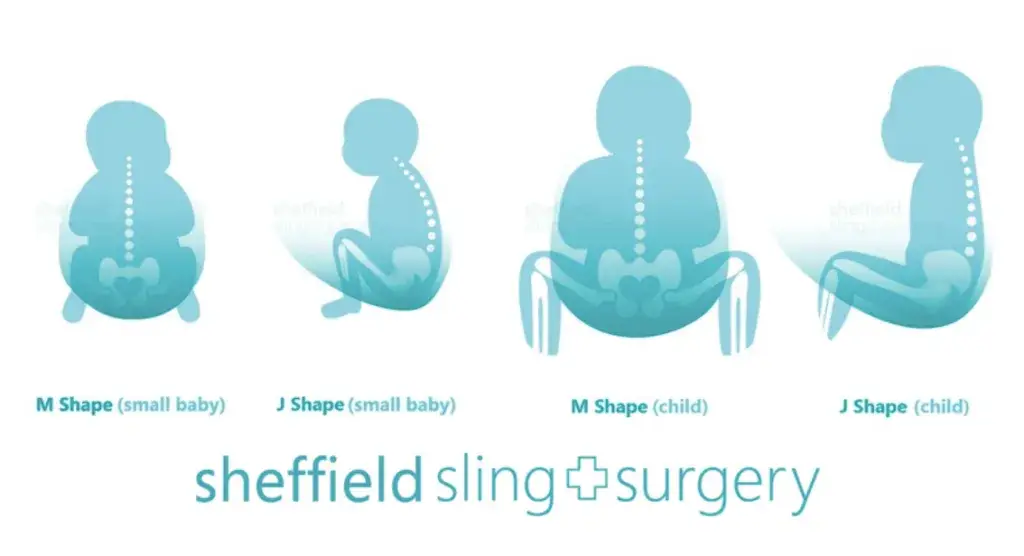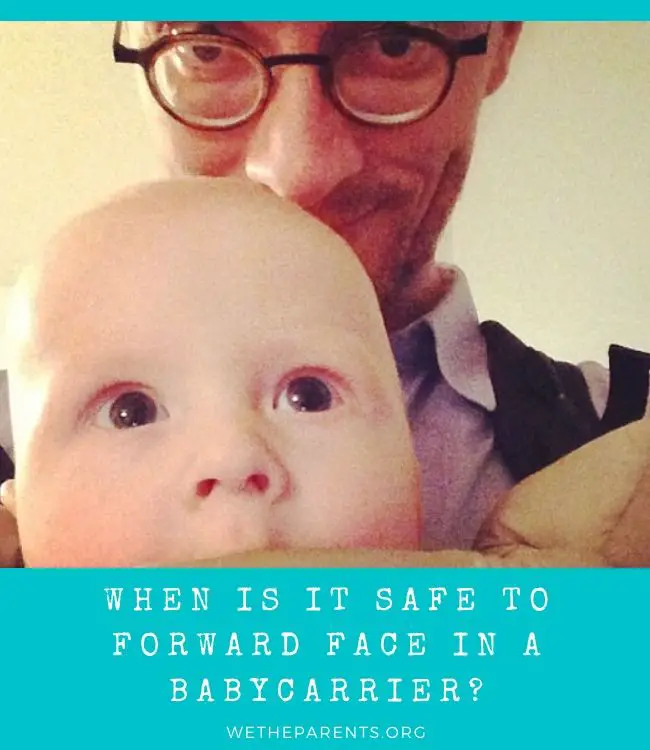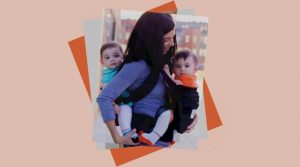As your child snuggles close to your chest during babywearing, it’s easy to see how this process creates a comforting parental bond.
While very young babies must be carried facing inward, as the months pass they’ll naturally become curious about the world around them and begin exploring. This is usually a good time to consider a front-facing carry.
Responsible babywearing is about following the guidelines offered by your carrier’s instructions or pediatrician, though some parents are still hesitant to try a new carrying style or may feel unsure if their baby is old enough yet.
Some even decide to opt out of the carry style altogether. In this article, we’ll discuss why that is, as well as the safety guidelines and age limits you should be aware of before trying a front-facing carry with your baby.
Are there any reasons I wouldn’t want my baby to face forward?
Let’s get the negative stuff out the way first. Yes, there are a few reasons why a front-facing carry is occasionally considered inferior to other methods.
However, the facts are that as long as the carry is performed correctly and safely, which means following carrier and pediatrician recommendations for age and weight, along with the TICKS method, there’s really nothing to fear.
TICKS method 1Using TICKS to check you’re babywearing safely: images
babycentre.co.uk/l25020081/using-ticks-to-check-youre-babywearing-safely-images
- Tight
- In view at all times
- Close enough to kiss
- Keep chin off chest
- Supported back
Related: Easy, Effective Babywearing Workouts for New Moms
Here are the potential cons of the front-facing carry:
- It’s not the best ergonomic carrying position for baby: When your little one is in a forward-facing carry position, their back naturally arches, which places all their weight at the base of the spine; that’s not as comfortable as the naturally accommodating curve of the inward-facing carry position. It’s also harder for them to maintain the healthy M-shape leg position recommended to avoid skeletal problems in babies.
- The M-shape leg position is the position of baby’s legs and hips while in the carrier.

- A lack of head and neck support: Head and neck support is essential for young children, especially babies who can’t hold their head up yet, which is why front-facing carry is always discouraged till babies reach four months. Even older babies and toddlers are at risk of positional asphyxia if their chin falls toward their chest while asleep, which can happen more easily in a front-facing carry.
- It’s not as comfortable for the wearer: Other positions, such as inward-facing or a back-carry, tend to be more comfortable because they naturally allow the two of you to share a center of gravity. When wearing your baby in a front-facing carry, this is no longer the case. The result may be back pain both during and after the carry and an uncomfortable pulling sensation on your shoulders during wear, especially as baby gets older and larger.
- It can be overstimulating: Babies are vulnerable to overstimulation when they’re around bright lights, loud sounds, and crowds; when they’re being carried in front-facing position they can’t shield themselves from the world, which can feel quite overwhelming and result in agitation. When babies are carried facing inward, they’re able to take in their surroundings while also sheltering themselves from excess stimulation.
When can babies face forward in carrier?
Because infants need consistent head and neck support, their bodies simply won’t cope with a front-facing carry.
To be sure you can safely carry your baby front-facing, wait until they reach 4 to 6 months.
Always follow your carrier’s instruction manual, and your pediatrician’s guidelines, to keep your baby safe.
What carriers can I use for front-facing carry?
Of course, the first step to trying out this method is knowing which carriers allow for it. Each of these babywearing carriers allows you to perform a front-facing carry.
Ring slings
- These carriers are comprised of a long strip of fabric which is secured by a ring, thus creating a secure pouch in which your child sits
- They’re generally available in sizes, which isn’t always the case with babywearing carriers
- They’re simple to learn and use compared to other worn carriers
Baby Wraps
- These carriers are comprised of an extra long strip of fabric which must be folded and tied to create a secure carry for your child
- They can be stretchy, which is better for infants; or woven, which is best for older, larger babies and toddlers
- In the beginning, these carriers can pose a bit of a learning curve, but stretchy ones are more forgiving and can make learning to tie easier
- Some woven wraps may be used until children are preschool age, but always follow guidelines provided by the carrier
Structured Soft Carriers
- There’s no wrapping or tying required with these carriers, and the straps and buckles are generally easier to adjust than other worn carriers
- The carrier straps are padded, which can alleviate discomfort on the wearer’s shoulders and upper back
- There’s a defined seat for baby to pop right into — though some picks require an insert that’s sold separately in order to safely accommodate an infant
Mei Tais
- These carriers combine the best of both worlds, using both a structured seat that’s comfortable for baby and long fabric strips that can be adjusted and tied to secure the carrier
- They’re easy and comfortable to wear and adjust, though parents should be aware that they’re not great for hip carries or for publicly feeding baby
Related: Best Mei Tais Carriers Of 2021
How do I use my carrier for front-facing carry?
Of course, the correct parameters for executing this carry will depend on the type of carrier you have and its instructions.
Likewise, your carrier may have different age or weight limitations for a front-facing carry than a particular one you’ve seen online — so always refer to your carrier’s instructions first.
The following are some general guidelines for correctly performing a front-facing carry with the four most common types of worn baby carriers.
Performing a forward carry with a ring sling
- First, thread the sling through the rings, and place it over your shoulder as you typically would.
- Separate the material’s top rail in order to create a space for baby to be carried in
- While grasping both rings, tug the sling’s bottom rail in order to secure the length of it that crosses your body
- Move the sling’s fabric down to the middle of your chest or thereabouts, being sure that it’s flush against your stomach
- If necessary, re-secure the bottom rail
- Insert baby into the wrap, positioned with their back securely resting against your chest
- Cross baby’s feet, folding their legs into a healthy M position; then, tuck them into the ring sling, securing them by tugging up the top part of the fabric
- Secure baby with your non-dominant hand while using your dominant hand to secure the ring sling’s top rail around your child
- Baby seems to be sagging? Use your non-dominant hand to lift them from the bottom, and use your dominant hand to secure the middle rail, which will make their seat more taut and place them higher on your body during wear
Related: The Best Ring Slings You Can Buy In 2021
Performing a forward carry with a soft carrier
- Put on your carrier as you normally would, fastening the buckle and waist strap to secure, moving any extra webbing through the safety band to allow for easy adjustment
- Position the carrier so that it’s sitting squarely on your hips, tightening your waist strap in order to secure it
- Test the shoulder straps for evenness before placing baby in the carrier, performing any necessary adjustments; unfasten them before you place your child in the carrier
- Baby should be positioned so that their back rests flush against your chest and their legs are in a healthy M position on each side of your carrier
- Use one of your hands to hold baby while you fasten each strap on opposite shoulders
- Fasten the straps located behind your neck, tightening them to secure, and double check that the TICKS guidelines are being followed
Related: Tula Ergonomic vs. Lillebaby All Seasons (2021 Comparison Guide)
Performing a forward carry with a fabric wrap
- Locate the middle of your wrap, draping it over your stomach, and carefully gather the fabric while ensuring that it’s not being twisted
- Both tail ends should wrap around each side of your waist and be crossed behind your back
- Move the tail ends upwards, draping them over each shoulder like a scarf and double checking that the material remains smooth and untwisted
- Create a pouch to place baby in by pulling the section of the wrap that’s across your stomach
- Place baby into the pouch with their back flush against your chest, with their knees lifted to their chest and their feet outside the pouch
- Tighten the bottom of the pouch by increasing the tension of the bottom rail thread, tucking the tail under your child’s bottom
- The tail ends will again cross around your waist, then tying behind your back in order to finish the wrap
- Adjust the criss-crossing front fabric X of your carrier by spreading out the fabric to add more comfort and support for your little one, and ensure that their legs are in a healthy M position
Performing a forward carry with a mei tai
- Place the carrier so that its front flap points towards you, face down; wrap the bottom straps around each of your sides and tie them behind your back?
- Sit down in a chair and hold your child in your lap, facing outward, with their back flush against your chest
- Ensure that baby’s legs are in a healthy M position by crossing their feet underneath them
- The carrier’s main body should then be tugged up over your child, and shoulder straps should be fastened, laying flat against your skin
- Hold your baby with one hand while reaching behind your back with the other to secure the shoulder straps
- Pull the straps back around to the front and knot them to finalize the carry
A front-carry FAQ
Is it safe for my baby to sleep in front-facing carry?
While it’s natural for your baby to be so comfortable and relaxed while being worn that they drift off to sleep, it’s important that they don’t do so while being carried in a front-facing position.
Even toddlers are vulnerable to positional asphyxia in this position, which is caused when the chin drops toward the child’s chest, possibly suffocating babies and toddlers by cutting off their airways.
If it’s close to baby’s nap time or you’re going to be carrying them for a while, consider an inward-facing carry so they can rest safely.
Is it okay if my baby’s head leans forward while front-facing?
No, this is NOT okay. This can be a problem for several reasons.
Not only does it make babies vulnerable to positional asphyxia and neck injury, but also indicates that they’re not yet physically developed enough to be carried in a front-facing position.
For their safety, they’ll need to be carried inward-facing until their neck muscles are more fully developed.
Is it normal for my baby to be fussy/dislike front carry position?
You’ll have learned in your baby’s first weeks and months of life that they quickly develop their own preferences. This includes the ways in which they’re carried.
It’s perfectly normal for some children to find front-facing carry to be uncomfortable or overstimulating, preferring inward-facing or hip carry instead.
They may also not like front-facing when they’re feeling tired, as it’s neither a comfortable nor safe position for them to doze off in.








